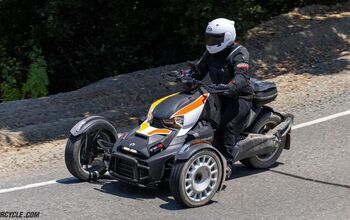2025 Kawasaki Versys 1100 Officially Announced

Updates include a larger engine and revised gearing
Kawasaki Europe has officially announced the new 2025 Versys 1100, available in three variants, Standard, S, and SE. The announcement confirms our earlier reporting that the Versys range is getting a larger engine but no significant styling changes from the previous Versys 1000 models.
Read More:
Visually, the new Versys looks pretty much the same as the 1000, except for new graphics and a subtle “1100” on the radiator shrouds. This seems like an odd decision, as manufacturers typically offer a refreshed look when making significant changes to the engine, which leads us to believe the displacement increase is mainly to help update the Versys to meet Euro5+ requirements.
The engine remains an Inline-Four, but Kawasaki increased the stroke by 3 mm to 59.0 mm, while keeping the bore at 77.0 mm. That works out to a displacement of 1,099cc, compared to the previous engine’s 1,043cc. The compression ratio was also increased to 11.8:1 from the previous 10.3:1. New cam profiles reduce the amount of valve lift, while the middle two intake funnels are now 45 mm longer than the outer funnels. Along with new ECU settings, Kawasaki says the changes result in higher intake flow velocity, improving torque delivery between 4,000 and 7,000 rpm. Kawasaki claims a peak output of 99 kW (133 hp) at 9,000 rpm, an increase over the 118 hp claimed by the Versys 1000. Torque peaks at a claimed 112.0 Nm (82.6 lb-ft.) at 7,600 rpm, compared to the peak of 75.2 lb-ft. from the 1000.
Other changes include a heavier flywheel and a secondary balancer, and new connector pipes joining exhaust headers 1 with 4, and 2 with 3. Kawasaki also added an oil cooler to improve cooling.
Kawasaki also updated the transmission ratios and replaced the previous 43-tooth rear sprocket with a 42-tooth sprocket, while keeping the same 15t front sprocket. The quickshifter was also updated, now working at a lower shift point of 1,500 rpm.
The rest of the bike is largely unchanged, except for a new bar-mounted USB-C port and a larger 260 mm rear brake disc (the Versys 1000 used a 250 mm disc).
For European markets, the Versys 1100 will be available in three trims. The standard Versys 1100 will be available in Metallic Matte Graphene Steel Gray with Metallic Diablo Black. The Versys 1100 S adds handguards, a TFT display, and smartphone connectivity, plus an additional color option of Pearl Robotic White/Metallic Diablo Black. The Versys 1100 SE adds Showa electronically damped suspension, and the same color options as the S model.
We haven’t heard anything yet about U.S. availability, though Kawasaki is teasing an announcement for Oct. 1. When it is confirmed, we expect Kawasaki will have different trim options. The Versys was last offered in the U.S. as a 2023 model as the Versys 1000 SE LT+ with the electronic suspension and luggage as standard equipment.
We’re also expecting news about a 2025 Kawasaki Ninja 1100SX with the same engine updates.
UPDATE Oct. 1, 2024
Kawasaki has now announced the U.S. will get the Versys 1100 SE LT for 2025. That's similar to the SE model offered in Europe, but with luggage standard. MSRP is $19,499.
Kawasaki has also confirmed the Ninja 1100SX for the U.S. market.
Specifications | 2025 Kawasaki Versys 1100 SE LT |
|---|---|
Engine Type | 4-Stroke, Liquid-Cooled, DOHC, 4 Valve Cylinder Head, Transverse In-Line 4-Cylinder |
Displacement | 1,099cc |
Bore & Stroke | 77.0 x 59.0 mm |
Torque | 75.2 lb-ft at 7,500 rpm (claimed) |
Compression Ratio | 11.8:1 |
Fuel System | DFI with Keihin 38mm ETV throttle bodies (4) |
Transmission | 6-Speed with positive neutral finder |
Final Drive | Sealed Chain |
Rake/Trail | 27°/4.0 in |
Front Tire | 120/70-17 |
Rear Tire | 180/55-17 |
Wheelbase | 59.8 inches |
Front Suspension | 43mm inverted fork with KECS-controlled compression and rebound damping and manually-adjustable preload; 5.9 inches of travel |
Rear Suspension | Horizontal back-link, KECS-controlled compression and rebound damping and electronically-controlled preload adjustment; 5.9 inches of travel |
Front Brake | Dual 310mm disc with 4-piston caliper, ABS |
Rear Brake | Single 260mm Disc, ABS |
Fuel Capacity | 5.5 gallons |
Seat Height | 33.1 inches |
Curb Weight | 571.1 pounds (claimed) |
Warranty | 24 months (Kawasaki Protection Plus 12, 24, 36 or 48 months) |

Dennis has been a part of the Motorcycle.com team since 2008, and through his tenure, has developed a firm grasp of industry trends, and a solid sense of what's to come. A bloodhound when it comes to tracking information on new motorcycles, if there's a new model on the horizon, you'll probably hear about it from him first.
More by Dennis Chung





































Comments
Join the conversation
much under rated road engine is the 1043cc, bit more torque always welcome. I hope they put it in some light(er) bikes.
I have put 35k on a Versys. All these changes, though suttle, address the few short comings of the bike. It is a great do-it-all bike. The best change to the bike would be a seat that can be used for more than 50 miles. Absolutely the worst seat I have ever sat in.